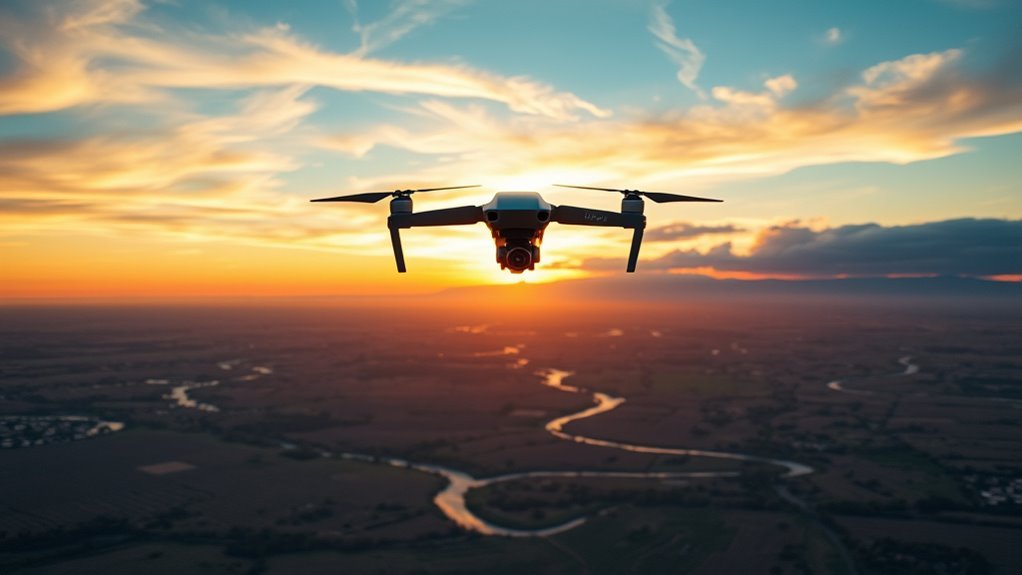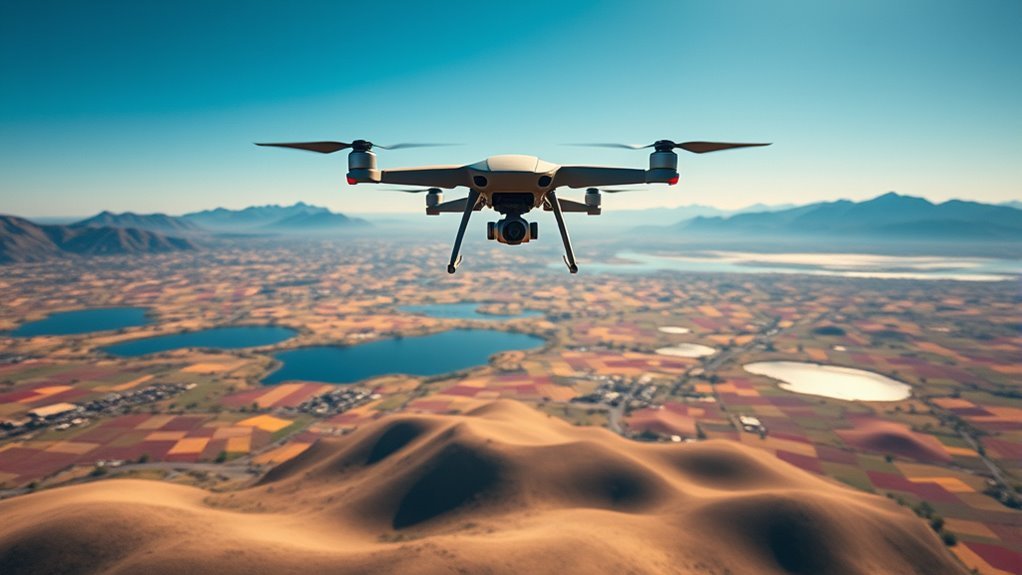You can expect your drone to fly anywhere from 1 to 30 kilometers, depending on factors like battery capacity, drone design, payload weight, and communication systems. Environmental conditions like wind and temperature also greatly impact range, as do legal restrictions that limit operation. Consumer drones usually offer shorter distances than professional models. Improving battery efficiency, optimizing flight paths, and minimizing weight can extend flight time. Understanding these elements will help you maximize your drone’s performance and range.
Factors Influencing Drone Flight Distance

Although drone flight distance can vary widely, several key factors directly influence how far your drone can travel on a single flight. One of the primary elements is drone design, which encompasses aerodynamics, motor efficiency, and structural materials. A streamlined design reduces drag, enabling longer, more efficient flights. Weight considerations are equally critical; the heavier your drone, the more power it requires to stay airborne, thereby reducing range. Balancing payload capacity against overall weight is essential for maximizing distance without sacrificing functionality. Additionally, the distribution of weight affects stability and maneuverability, which indirectly impacts flight endurance. Understanding these design and weight factors allows you to optimize your drone for extended freedom in the air, pushing the limits of its operational range with precision and control.
Battery Life and Its Impact on Range

Because battery life directly determines how long your drone can stay airborne, it plays an essential role in defining its maximum flight range. The core factor here is battery capacity, usually measured in milliampere-hours (mAh) or watt-hours (Wh). A higher capacity means more stored energy, granting extended flight time and consequently increased range. However, capacity alone isn’t enough; efficient power management optimizes energy use, ensuring your drone doesn’t waste precious battery on non-essential functions. Flight mode, payload weight, and environmental conditions affect power consumption, so intelligent power management systems adjust output dynamically. By understanding and maximizing battery capacity alongside power management, you can push your drone’s operational limits, experiencing true freedom in the skies without constantly worrying about draining your battery prematurely.
Signal Strength and Communication Limits

When you operate a drone, the strength of its signal and the limits of communication directly influence how far it can fly from your controller. Your drone relies on robust communication protocols, such as Wi-Fi, RF, or proprietary systems, to maintain a constant link. Signal interference from obstacles, other electronic devices, or atmospheric conditions can degrade this link, forcing your drone to stay within a defined radius to avoid losing control. The effective range is therefore bounded by both transmitter power and receiver sensitivity, as well as environmental factors. To maximize freedom, you need a system designed to minimize interference and utilize advanced protocols that support dynamic frequency hopping and error correction. Understanding these limits guarantees you exploit your drone’s full operational range safely and efficiently.
Differences Between Consumer and Professional Drones
When comparing consumer and professional drones, you’ll notice significant differences in flight range, primarily driven by battery capacity and efficiency. Professional models often have extended battery life, enabling longer operational distances without compromising performance. Understanding these distinctions helps you gauge which drone suits your specific range requirements.
Flight Range Comparison
How far can drones really fly, and what distinguishes consumer models from professional ones regarding flight range? When comparing drone types, consumer drones typically offer ranges between 1 to 7 kilometers, optimized for casual use and regulatory compliance. In contrast, professional drones extend considerably further, often reaching 10 to 30 kilometers or more, thanks to advanced communication systems and enhanced GPS integration. This range disparity reflects design priorities: consumer models balance ease of use and portability, while professional units emphasize operational freedom and mission-critical reliability. Understanding these range comparisons helps you select a drone that matches your need for spatial freedom, whether for recreational exploration or demanding aerial tasks. Remember, flight range is a critical factor defining the operational envelope and your capability to explore beyond visual line of sight.
Battery Life Impact
Although flight range is essential, battery life fundamentally limits how far your drone can go before needing a recharge. Understanding the differences between consumer and professional drones hinges on three core factors related to battery life:
- Battery Efficiency: Professional drones utilize advanced lithium-polymer cells optimized for energy density, extending flight times beyond consumer models that typically use standard lithium-ion batteries.
- Charging Technologies: Rapid charging and swappable battery systems in professional drones minimize downtime, whereas consumer drones often rely on slower, fixed charging setups.
- Power Management: Professional drones incorporate sophisticated power management algorithms that optimize battery consumption based on flight conditions, enhancing operational freedom.
Environmental Conditions Affecting Flight Range
You need to account for environmental factors like wind and temperature when evaluating a drone’s flight range. Strong headwinds increase power consumption, reducing distance, while tailwinds can extend it. Additionally, low temperatures degrade battery efficiency, limiting overall flight time.
Wind Impact on Distance
When drones encounter varying wind conditions, their effective flight range can be considerably altered due to changes in power consumption and stability requirements. You’ll notice that wind resistance forces your drone’s motors to work harder, quickly draining the battery. Altitude effects also play a role, as thinner air reduces lift but may increase wind speed variability. To optimize your drone’s flight distance under wind influence, consider these factors:
- Headwinds drastically reduce range by increasing energy use to maintain speed.
- Crosswinds challenge stability, requiring constant adjustments that elevate power draw.
- Tailwinds can extend range but demand precise control to avoid overshooting targets.
Understanding these dynamics guarantees you maintain control and maximize freedom during flight missions.
Temperature Effects on Battery
Since battery performance is highly sensitive to temperature fluctuations, understanding how environmental heat or cold impacts your drone’s power source is essential for predicting flight range. Battery efficiency declines markedly outside ideal temperature ranges, typically between 20°C and 25°C. When temperatures drop below this, chemical reactions within the battery slow, reducing voltage output and capacity, which shortens flight time. Conversely, excessive heat accelerates internal degradation, increasing resistance and risking thermal runaway, which also diminishes efficiency. You’ll notice that colder conditions can cause up to a 30% reduction in flight duration, while high heat may lead to unpredictable battery behavior. To maximize your drone’s freedom in the air, consider pre-conditioning batteries and monitoring ambient temperature, ensuring you operate within ideal temperature ranges to maintain consistent, reliable flight performance.
Legal Restrictions on Drone Flight Distance
Several jurisdictions impose strict legal restrictions on how far drones can fly, primarily to guarantee safety and privacy. As you navigate drone regulations, understanding airspace restrictions is essential to avoid violations and penalties. Typically, these rules limit your drone’s operational radius based on:
- Visual Line of Sight (VLOS) requirements, mandating you keep the drone within direct view.
- Maximum altitude caps to prevent interference with manned aircraft.
- No-fly zones near airports, military bases, and sensitive locations.
While these constraints may seem limiting, they’re designed to protect both national security and public safety. To preserve your freedom while complying, stay informed about local drone regulations, use geofencing technology, and plan flights meticulously. Balancing legal boundaries with your drone’s capabilities guarantees responsible and lawful operation.
Technology Advancements Extending Drone Range
Although legal restrictions limit how far you can fly drones, technological advancements have considerably expanded their potential operational range. Improvements in drone technology, particularly in battery efficiency and lightweight materials, have directly contributed to enhanced flight durations and distances. Additionally, innovations in communication systems, such as long-range radio frequency modules and satellite links, enable more reliable control over extended distances. Enhanced GPS accuracy and autonomous navigation algorithms also support consistent range extension by reducing signal loss and optimizing flight paths. As these technologies evolve, they collectively push the boundaries of drone capabilities, granting you greater freedom to explore expansive areas. Understanding these advancements allows you to appreciate how drone technology is engineered to maximize range while maintaining safety and reliability within existing legal frameworks.
Tips for Maximizing Your Drone’s Flight Distance
Expanding your drone’s flight distance goes beyond relying solely on advanced technology; it requires strategic planning and operational choices. To maximize your drone’s range, focus on these key aspects:
- Battery Optimization: Ascertain your batteries are fully charged and well-maintained. Use high-capacity, lightweight batteries and calibrate them regularly to maintain peak performance and avoid sudden power loss.
- Weight Reduction: Minimize payload by removing unnecessary accessories and choosing lightweight components. Every gram saved reduces energy consumption, directly enhancing flight duration and distance.
- Flight Planning: Optimize your flight path to avoid strong headwinds and turbulence, which drain battery power faster. Flying at moderate speeds and altitudes also conserves energy, allowing your drone to travel farther.
Implementing these steps strategically will grant you greater operational freedom, pushing your drone’s flight capabilities to their maximum potential.
Real-World Examples of Drone Flight Ranges
How far can drones actually fly in real-world conditions? Flight experiences show that drone applications vary greatly in range due to factors like battery life, signal strength, and environment. Here’s a precise analysis of typical flight ranges across common drone models:
| Drone Model | Max Flight Range (km) | Primary Drone Applications |
|---|---|---|
| DJI Mavic Air 2 | 10 | Photography, surveying |
| Autel EVO Lite | 12 | Inspection, mapping |
| Skydio 2+ | 6 | Autonomous navigation |
| Parrot Anafi | 4 | Recreational, lightweight |
| DJI Phantom 4 | 7 | Commercial filming |
You’ll notice freedom in flight distance hinges on model capabilities and use cases. Understanding these will optimize your drone applications and deliver satisfying flight experiences.

